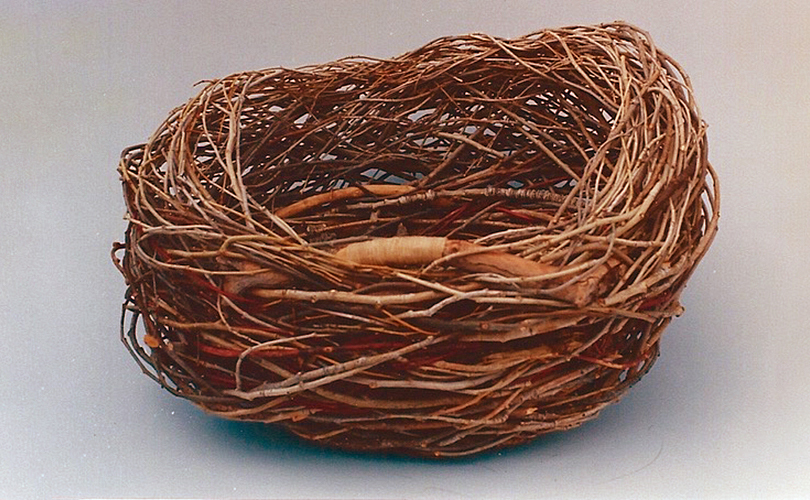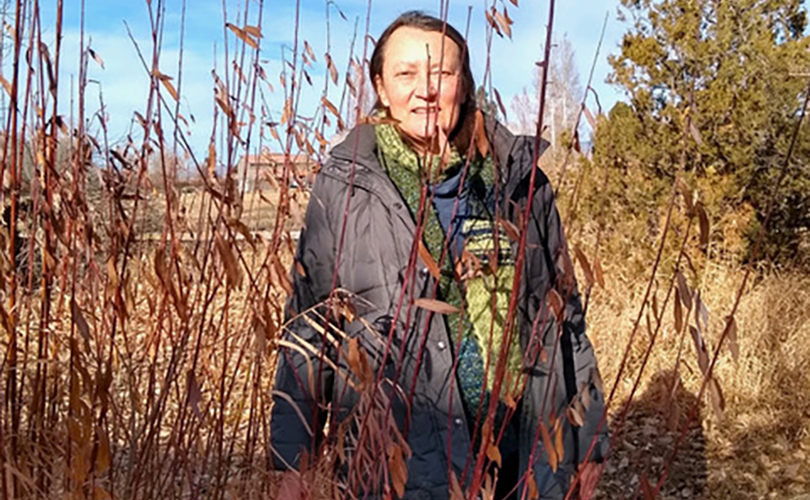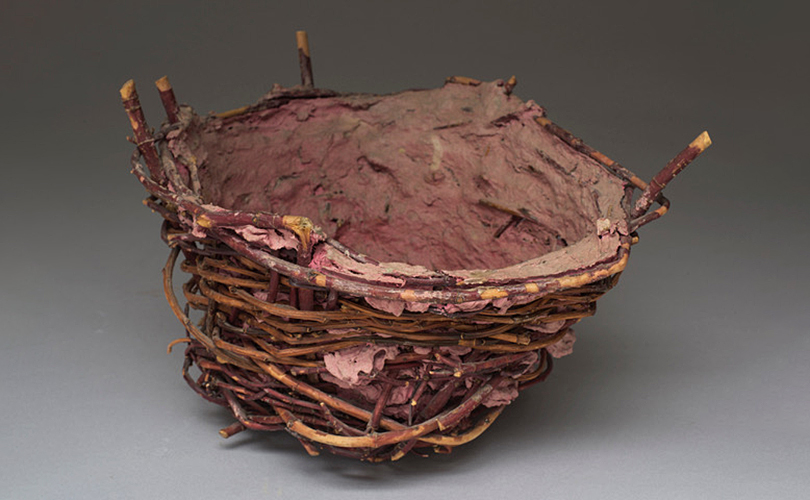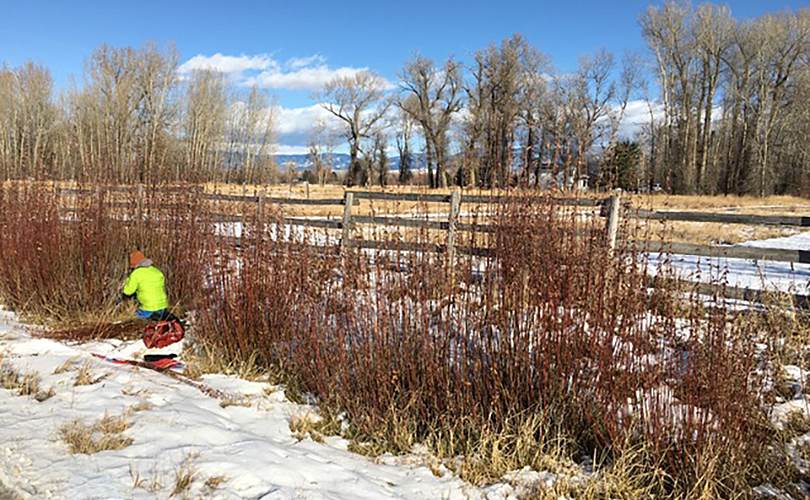
In July, I was invited to speak at the NBO Virtually Woven conference on the subject of how I collect the natural material I use to weave my sculptural baskets. I was initially reluctant, as I have had little experience with Zoom, and I questioned how much I would have to say about my collecting process. I am glad that I accepted the invitation as I discovered that virtual conferences are great. They provide an opportunity to see and hear many different people in their studios talking about the work they do. There is something casual and friendly about it. I am also glad because it gave me the opportunity to recall how my basketmaking all began.
My annual practice of collecting willow, which I have been doing for the last 40 years, is a process that actually began 10 years before I ever considered making a basket.

In the summer of 1973, I was staying at my parents’ home in rural, upstate New York. My mother and I took a class in rug braiding from a local woman. She had a large barn that stood empty until fall when the apple harvest would fill it up. While the barn was empty, she made rugs and taught others how it was done. What ensued after the first class was a summer of enthusiastic hunting, processing, and braiding. My mother and I became a focused team and there was a rhythm to our days.
We would go out early to hunt in second-hand clothing stores for wool garments. We would return home delighted with our discoveries. We would deconstruct the clothes, then wash and dry them, and cut them into strips. We sewed the short strips into long strips, then braided them. I was in charge of the braiding, usually staying up late into the night to braid all the material we had prepared.

By the end of the summer our rug was finished. It had been a fine obsession, made better by sharing it with my mom. The hunting, gathering, preparing, and creating process had become a part of me that I would put to use 10 years later when I decided to make a basket.
By the spring of 1982, my interest in making rugs was waning. I felt I needed a change and making a basket didn’t seem so much different from making a rug. So I went hunting in my back yard. I started cutting branches, stalks, whatever looked promising. I wasn’t looking for willow at the time, or any particular kind of plant, just branches that might work to create a basket shape. I used string to tie some of the branches together when I couldn’t get them to hold in place. What I remember most of that first time collecting material is the feeling of adventure and fun and wonder. Similar to the excitement I felt when I began braiding rugs.

I hadn’t planned on continuing to make baskets. Luckily, I met someone who was also new to weaving baskets. She had taken classes from a willow basketmaker and was starting to collect her own material, so I joined her and learned a lot just by watching how she collected. I had a tendency to make big messy piles of sticks. She neatly laid her sticks out straight and then tied them in bundles. I followed her example when I saw how easily she could pack those bundles into her car. Collecting with my new friend increased my interest in making baskets. Having a friend, or a community, can do that.
Once I knew what willow looked like, I started seeing it everywhere. I would discover a patch growing in the summer and take note to return to it in the fall. I learned early on that fall, when the sap was down and the leaves had fallen, was the best season to collect. In my early forages for material, I cast a wide net. I could identify willow and I knew it was a traditional basket material, but I also collected rocks, pieces of bark, interesting sticks, cottonwood, cattail, and snake grass.
Sometimes I would climb the yellow willow trees to cut the suckers only to discover the tree willow is rather snappish. What ever I collected I would haul back home and play around with to see if I could construct baskets with the material. I remember being totally engaged with this task. I sometimes wonder if I am related to a magpie, those large beautiful birds that build huge nests in trees and line the nests with objects that they collect.

I discovered a book by Char Ter Beest called Wisconsin Willow where she described how she collected her material along roadsides and in patches in Wisconsin. I still remember her advice to always take food and water because once you start collecting you don’t want to stop. I took it to heart, and never venture out without something to eat and drink.
I liked using the willow right after I collected it, when it was fresh and flexible. This meant I would have to weave with it before it dried so much it couldn’t be bent. This is different from a traditional willow basket maker who would dry the willow completely and then soak it. Soaking it makes it flexible again, and it shrinks less than fresh willow does. I had tried soaking willow, but I never really got the hang of it.
I have had to adjust my weaving style to compensate for the major shrinkage that happens with the green willow. I also started storing my willow in a freezer at the suggestion of Joanne Schantz, a willow basket-maker and teacher of the Amana Colonies. She said it would keep until I was ready to weave and also keep the willow bug-free. This information was very useful because I could prolong the fresh state of the willow for years.
Until 1999 I collected in many different places. Some close enough to home I would walk with a pack-basket to carry the sticks. Sometimes I would go as far away as Wyoming, a five-hour drive.
In all this collecting I learned a lot about willow, and it became my primary focus. How the feel of the withe could tell me a bit about how it would weave. How the look of the bark was an indication of health. Some years the willow would be pocked and breakable, and I would cut it down and put it directly in the compost.
I would cut it even though I couldn’t use it because I had discovered the best willow to weave with was the year-old growth. Cutting a year-old branch down to the ground and leaving enough length for more branches to grow from the nodes is called coppicing. It is a way to stimulate growth and does not hurt the willow. The next year the willow would come back and be healthy again and more abundant.

I learned not to collect on a windy day. Wearing glasses is good protection for the eyes. It can really hurt to have a stick whip back and smack you in the face. Collecting alone can be a wonderful meditative time. Collecting with a friend is a wonderful shared experience. A little of both is a great combination.
In 1999 I was invited to collect a friend’s willow. She had planted it, but discovered it was much bigger than she wanted. I went out to look and discovered the most beautiful tall willow. My husband and I cut it all down, and it was enough to fill my freezer. For the past 22 years that has been my main source of material. I am thankful I have a patch I can count on. The area I live in has changed a lot since my early days, and I am reluctant to collect in public areas and during hunting season. All the places I go now are privately owned. People who live close to a potential forest fire area keep the land around their house cut and free of brush. I frequently benefit from this practice and my gathering in these areas is welcome.
I look back at how I started with great enthusiasm, but little knowledge. I knew I had the tenacity to figure it out because I had first-hand knowledge of hunt, gather, process, and create. I didn’t have my mom with me this time or an instructor, but I met friends, read books, and joined guilds.
I also had willow, a material that continues to amaze me with its abundance and beauty. It delights all my senses. When I see a bundle of willow, I think it is the most wonderful sight. When I am out in a patch, I feel like I am collecting something as valuable as gold.
Christine Joy
September 2022
